
General
Land area: 329,758 km2
Population (1990): 17,566,982
Per capita income (1992): US$ 3,275
Comprising the three separate territories of Malaya, Sarawak and Sabah, Malaysia stretches over 2,000 km from peninsular Malaysia to the northeastern end of the island of Borneo. It shares borders with Thailand, Indonesia and the enclave states of Singapore and Brunei. A central mountain chain divides Malaya, separating fertile western plains from a narrow eastern coastal belt. Sarawak and Sabah are characterized by swampy coastal plains rising to mountains on the border with Indonesia. Since 1987, Malaysia has been experiencing average economic growth rates of 8% a year.
Environmental concerns
Logging is the overwhelming environmental concern of groups such as Sahab Alam Malaysia (Friends of the Earth, Malaysia). Unprocessed log exports from Sarawak have risen from 6.7 million cubic metres in 1980 to 15.8 million cubic metres in 1991. World Bank estimates suggest that trees are being cut down at four times the sustainable rate. Indigenous forest communities such as the Pernan are being destroyed and some species of wood such as Ramin are near extinction. In 1992, the state of Sarawak began to take action to diversify the economy. There is great pressure to maintain economic growth, however, and the profits from logging are attractive.
Biodiversity
The species richness and endemism of Malaysia is of major global importance. It ranks 21st among all countries in absolute diversity and 20th when adjusted to the country's area. Peninsular Malaysia has a rich flora and fauna with large Asian components small Australian components. Deforestation and forest degradation have significantly affected wildlife populations especially in the lowlands.
Higher species richness in Malaysia
| Species group | Total species richness | Number of species endemic to Malaysia | Number of species shared with other countries |
| Mammals | 287 | 28 | 259 |
| Birds | 501 | 9 | 492 |
| Reptiles | 270 | 70 | 200 |
| Amphibians | 158 | 57 | 101 |
| Higher Plants | 15,000 | 2,700 | 12,300 |
| Total | 6,421 | 2,199 | 4,222 |
Conserving higher species
Malaysia is steward of 2,199 higher species found nowhere else on earth. About 18% are classified as threatened. The 3.5% of species classified as endangered are priority species for conservation measures such as habitat restoration, protected areas and special land management schemes. Endangered species are listed in Annex A.
Endemic species in Malaysia
| Class of species | Endemic species | |||
| Number of species | Number threatened | Number threatened that are endangered | ||
| Mammals | 28 | 1 | 0 | |
| Birds | 9 | 0 | 0 | |
| Reptiles | 70 | 0 | 0 | |
| Amphibians | 57 | 0 | 0 | |
| Higher plants | Ferns | 93 | 10 | 0 |
| Gymnosperms | 16 | 12 | 0 | |
| Dicots/Monocots | 1,926 | 381 | 78 | |
| Total | 2,199 | 404 | 78 |
Conserving centres of restricted-range birds and plant diversity
Two centres of restricted-range birds are in urgent need of conservation measures. Several centres of plant diversity are at risk and require protection.
Centres of plant diversity entirely within Malaysia
| Centres of plant diversity | Location | Assessment: Critical > Urgent > High |
| Endau-Rompin State Parks | Malaysia (Peninsular Malaysia) | Protection needs strengthening; at risk |
| Limestone flora of Peninsular Malaysia | Malaysia (Peninsular Malaysia) | Many outcrops severely threatened, some at risk, a few safe |
| Montane flora of Peninsular Malaysia | Malaysia (Peninsular Malaysia) | Most areas outside National Park are severely threatened |
| Palau Tioman | Malaysia (Peninsular Malaysia) | Threatened; protected status not enforced |
| Taman Negar | Malaysia (Peninsular Malaysia) | Safe at present, but frequently threatened |
| Trengganu Hills | Malaysia (Peninsular Malaysia) | At risk |
| East Sabah lowland/hill sipterocarp forests | Malaysia (Sabah) | Threatened, some areas seriously threatened; protection of reserves needs strengthening |
| Kinabalu Park | Malaysia (Sabah) | Boundaries strengthened |
| North-east Borneo ultramafic flora | Malaysia (Sabah) | Inadequate coverage of protected areas; threatened |
| Lambir Hills | Malaysia (Sarawak) | Encroachment around boundaries; threatened |
Distribution of ecofloristic zones
These are zones of potential vegetation. Six ecofloristic zones lie within Malaysia's territory.
Ecofloristic zones in Malaysia

Key to legend:
mangrove, swamp, lowland evergreen & hill forests, 126,444km sq
montane forests (1,000->1,600m), 5,586km sq
upper dipterocarp & montane oak forests, 341km sq
moist evergreen mixed & dipterocarp forests, <300m, 187,313km sq
tropical montane evergreen forests, 10,104km sq
tropical montane thickets, coniferous forests, 1,289km sq
Distribution of moist forests
The map depicts actual moist forest vegetation apparent at a regional level. Lowland rain forest covers 43% of Malaysia (west) and 74% of Malaysia (east).
Moist forest types in Malaysia

Protected areas
Currently 23.7% of Malaysia lies within protected areas.
Conserving ecofloristic zones
The mangrove, swamp lowland evergreen and hill forests zone requires greater protection.
Ecofloristic zone protection in Malaysia
Malaysia, insular

Malaysia, peninsular

Conserving moist forests
Mangrove, inland swamp and lowland rain forest in peninsular Malaysia require greater levels of protection.
Moist forest protection in Malaysia
Malaysia, insular
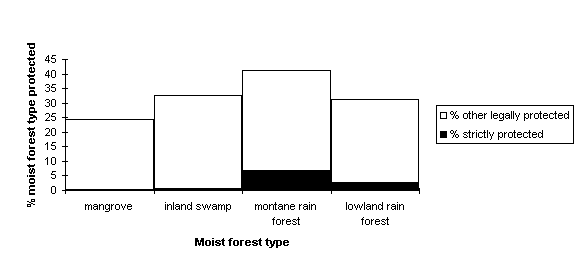
Malaysia, peninsular

Conserving endangered species
Malaysia shares a number of endangered species with neighbouring countries. These species may provide opportunities to focus bilateral or multilateral conservation strategies.
Endangered species shared between Malaysia and 1-5 countries
| Higher species group | Endangered species | Countries sharing species |
| Mammals | Pongo pygmaeus | Brunei |
| Cynogale bennettii | Brunei, Indonesia, Singapore, Thailand, Viet Nam | |
| Tapirus indicus | Indonesia, Laos, Myanmar, Thailand, Viet Nam | |
| Reptiles | Tomistoma schlgelii | Indonesia, Myanmar, Thailand |
| Callagur borneoensis | Brunei, Indonesia, Thailand | |
| Plants | Dendrobium flavidulum | Singapore |
| Dendrobium flexile | Singapore | |
| Eria pudica | Singapore | |
| Oberonia fabellata | Singapore | |
| Shorea richetia | Indonesia (Kalimantan) | |
| Shorea induplicata | Indonesia (Kalimantan) | |
| Nenga gajak | Indonesia (Sumatra) | |
| Pinanga adangensis | Thailand |
Conserving centres of restricted-range birds and plant diversity
These areas, shared exclusively with Indonesia, are subject to many threats. Developing and implementing multilateral biodiversity conservation strategies with Indonesia, is required.
Centres of restricted-range birds and plant diversity shared between Malaysia and neighbouring countries
| Centres of restricted-range birds | Location | Priority for conservation: Critical > Urgent > High |
| Bornean mountains | Malaysia, Indonesia | Critical |
| Sumatra and Peninsular Malaysia | Malaysia, Indonesia | Urgent |
| Centres of Plant Diversity | Location | Assessment |
| Lanjak - Entimau WS, Batang Ai NP, Gunung Bentuang dan Karimun | Malaysia/Indonesia | Boundaries and lower slopes at risk |
| Limestone flora of Borneo | Malaysia/Indonesia | Some major areas safe, some relatively safe but unprotected, most others threatened |
Conserving ecofloristic zones
The ecofloristic zones found in Malaysia are also found extensively in neighbouring countries. Malaysia might coordinate the development and implementation of ecosystem level conservation strategies with these countries (see charts over the page).
Conserving moist forests
Several moist forest types are regionally extensive in South-East Asia. These countries could be partners for sharing biodiversity conservation strategies (see charts over the page).
Transboundary protected areas
Protected areas that meet at international borders present opportunities for more effective protection and management of ecosystems and species. These protected areas pairs often conserve larger contiguous portions of ecosystems than normally possible within national borders thereby securing more habitat for species, especially those requiring large ranges. Ecosystem components such as lakes, rivers and mountains, which often define international borders, can be managed and conserved more effectively. Transboundary protected areas can provide opportunities for neighbouring countries to share knowledge and experience in ecosystem approaches to management. The establishment of formal management agreements centred on biodiversity conservation is one option.
Examples of transboundary protected areas in Malaysia
| Transboundary protected areas | Countries sharing | Type of area | IUCN category
| Size (hectares) |
| Lanjak Entimau Gunung Bentuang | Malaysia Indonesia | Wildlife Sanctuary Nature Reserve | IV |
168758 |
International Conventions
Malaysia is party to many global conventions and regional treaties/conventions that contribute to the conservation of species and ecosystems, including the Convention on Biological Diversity. By fully meeting its obligations under these agreements, Malaysia's biodiversity will be more assured. Harmonizing national and regional conservation strategies and action plans that meet the objectives of several conventions is one strategy (see table two pages on).
Distribution of Malaysia's ecofloristic zones in South-East
Asia
(only zones which occupy more than a 10% of Malaysia are shown)
Malaysia, insular
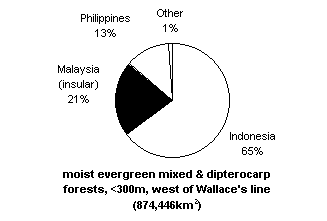
Malaysia, peninsular
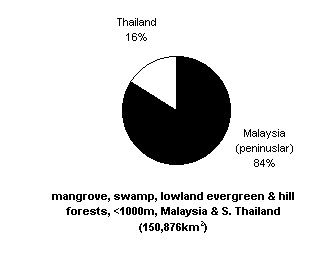
Distribution of Malaysia's moist forest types in South-East Asia
Malaysia, insular
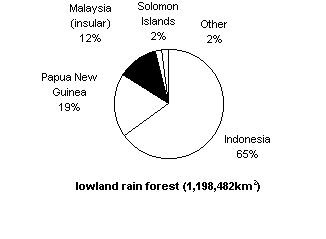
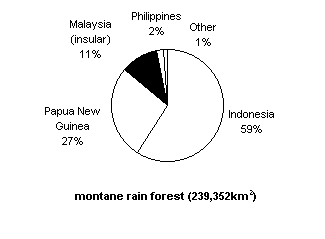
Malaysia, peninsular
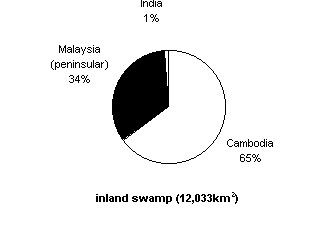

Multilateral conventions and treaties involving Malaysia
| Global Conventions | Year | Status |
| Convention on Biological Diversity (CBD, Rio) | 1992 | P |
| International Tropical Timber Agreement (ITTA, Geneva) | 1983 | P |
| United Nations Convention on the Law of the Sea (UNCLOS, Montego Bay) | 1982 | S |
| Convention on International Trade in Endangered Species of Wild Fauna and Flora (CITES, Washington) | 1973 | P |
| Convention concerning the Protection of the World Cultural and Natural Heritage (WHC, Paris) | 1972 | P |
| Convention on Wetlands of International Importance Especially as Waterfowl Habitat (Wetlands, Ramsar) | 1971 | D |
| Convention on the High Seas (High Seas, Geneva) | 1958 | P |
| Convention on Fishing and Conservation of the Living Resources of the High Seas (Liv. Res. High Seas, Geneva) | 1958 | P
|
| International Plant Protection Convention (Plant, Rome) | 1951 | P |
| Regional Treaties | Year | Status |
| ASEAN Agreement on the Conservation of Nature and Natural Resources (ASEAN Agt., Kuala Lumpur) | 1985 | S |
| Agreement Establishing the Southeast Asian Fisheries Development Center (SE Asian Fish, Bangkok) | 1967 | P |
| Amendment to the International Plant Protection Convention (Plant, Rome) | 1967 | P |
| International Plant Protection Convention (Plant, Rome) | 1956 | P |
Notes: D - terminated; P - State is a party to treaty (where treaty is not yet in force, the State has expressed its consent to become a party); S - signature only.
National investment
Malaysia has a high percentage of its land area in protected categories. The
national investment in protected areas is about average for the region but only 12% of the global average.
International investment
Official Development Assistance figures show that Malaysia received 0.18% of the total assistance given by major donor countries/agencies. The region of Oceania received 15% of the world total. The proportion directed to biodiversity conservation is unknown.
In general, countries with high biodiversity receive relatively low levels of domestic investment and little foreign aid.
Investment in Conservation
| Investment in Conservation | Amount | Regional/global context |
| Area protected | 23.7% of ecofloristic zones protected | Regional average is 3.6% land area protected for South and South-East Asia and 9.0% for Insular South-East Asia; global average is 5% |
| National investment (1991) | US$55.33 per km2, for 2,790 national per capita income | Global average is US$ 447/km2. Regional average is US$58 per km2 |
| Staffing levels for protected areas (1993) | No information | The global average is 15.7 persons per 1,000 km2. The regional average is 17.6 persons per 1,000 km2 |
| Official development assistance (1993) | Malaysia received US$ 101 million | Total ODA assistance was US$ 56.3 billion. Far East Asia received US$ 8,582 million |